Best Ordinals Wallets 2024: Top Ordinals Wallets Reviewed!
The article discusses the emergence of Ordinals, a protocol that allows for the creation and trading of unique digital assets directly on the Bitcoin blockchain. Ordinals leverage updates to the Bitcoin protocol to store image and video data along with transaction information on individual satoshis, the smallest unit of Bitcoin. Unlike NFTs on other blockchains, Ordinal NFTs can store the digital asset itself on the blockchain within a transaction's witness data.
The article highlights some of the key similarities and differences between Bitcoin Ordinals and Ethereum NFTs. Both are used to create, represent, and trade unique digital assets, and both undergo cryptographic verification for authenticity and ownership. However, there are notable differences in the storage location, minting process, royalties and ownership, scalability and ecosystem maturity between the two.
To safely manage Ordinals, the article emphasizes the importance of using a separate wallet specifically designed to support and safeguard these assets. It recommends several top Ordinals wallets, including The Ordinals Wallet, Xverse, Leather Bitcoin Wallet, Phantom Wallet, and OKX Wallet. These wallets offer features such as non-custodial storage, compatibility with other Bitcoin layers, customizability, security measures, and access to decentralized applications and exchanges within the Bitcoin ecosystem.
The article also provides tips for choosing the best Ordinals wallet, including considering security features, ease of use, compatibility, and the wallet provider's community trust and reputation. It offers practical tips for using a crypto wallet, such as backing up seed phrases securely, enabling two-factor authentication, regularly updating wallet software, being cautious of phishing attempts, verifying app authenticity, and staying informed about the latest security threats and best practices.
In conclusion, the article explores the concept of Ordinals and the differences between Bitcoin Ordinals and Ethereum NFTs. It emphasizes the importance of using a dedicated Ordinals wallet to manage these assets securely and recommends several top wallets based on their features and community reputation. By following best practices and utilizing the right wallet, users can effectively navigate and leverage the potential of Ordinals within the evolving cryptocurrency landscape.
The article discusses the emergence of Ordinals, a protocol that allows for the creation and trading of unique digital assets directly on the Bitcoin blockchain. Ordinals leverage updates to the Bitcoin protocol to store image and video data along with transaction information on individual satoshis, the smallest unit of Bitcoin. Unlike NFTs on other blockchains, Ordinal NFTs can store the digital asset itself on the blockchain within a transaction's witness data.
The article highlights some of the key similarities and differences between Bitcoin Ordinals and Ethereum NFTs. Both are used to create, represent, and trade unique digital assets, and both undergo cryptographic verification for authenticity and ownership. However, there are notable differences in the storage location, minting process, royalties and ownership, scalability and ecosystem maturity between the two.
To safely manage Ordinals, the article emphasizes the importance of using a separate wallet specifically designed to support and safeguard these assets. It recommends several top Ordinals wallets, including The Ordinals Wallet, Xverse, Leather Bitcoin Wallet, Phantom Wallet, and OKX Wallet. These wallets offer features such as non-custodial storage, compatibility with other Bitcoin layers, customizability, security measures, and access to decentralized applications and exchanges within the Bitcoin ecosystem.
The article also provides tips for choosing the best Ordinals wallet, including considering security features, ease of use, compatibility, and the wallet provider's community trust and reputation. It offers practical tips for using a crypto wallet, such as backing up seed phrases securely, enabling two-factor authentication, regularly updating wallet software, being cautious of phishing attempts, verifying app authenticity, and staying informed about the latest security threats and best practices.
In conclusion, the article explores the concept of Ordinals and the differences between Bitcoin Ordinals and Ethereum NFTs. It emphasizes the importance of using a dedicated Ordinals wallet to manage these assets securely and recommends several top wallets based on their features and community reputation. By following best practices and utilizing the right wallet, users can effectively navigate and leverage the potential of Ordinals within the evolving cryptocurrency landscape.
Bitcoin has traditionally been associated with long-term investments and financial storage — that's why it's often likened to digital gold.
However, as the cryptocurrency ecosystem continues to evolve, other blockchains have emerged to fulfil diverse purposes, such as facilitating non-fungible tokens (NFT) and decentralized applications (DApps). While Bitcoin wasn't initially designed to accommodate these functionalities, the blockchain has seen an influx of protocols introducing new assets and functionalities over time. Among these innovative assets are Ordinals.
Ordinals represent experimental assets within the Bitcoin ecosystem, offering opportunities for digital asset ownership and trading. For anyone looking to venture into this realm, the selection of a suitable wallet capable of supporting and safeguarding these alternative Bitcoin assets is essential.
In this article, we will explore the best Ordinals wallets, shedding light on what Ordinals are and how they're different from traditional NFTs. We will also delve into the essential criteria for selecting the top Ordinals wallets.
What Are Bitcoin Ordinals?
Bitcoin Ordinals is a protocol that allows individual satoshis (the smallest unit of Bitcoin) to be uniquely identified and transacted with additional data attached. This protocol effectively enables the creation of NFTs directly on the Bitcoin blockchain.
Ordinals leverage updates to the Bitcoin protocol to store image and video data along with transaction information. Unlike NFTs on other blockchains, Ordinal NFTs can store the digital asset itself on-chain within a transaction's witness data.
Creating an Ordinal NFT involves sending a satoshi to a Taproot-compatible wallet and including data and metadata as part of the transaction. Once mined, the inscription is permanently recorded onto the satoshi.
And they've been a hit!
According to Dune, there have been roughly 65 million inscriptions to date generating about $447 million in fees.

Bitcoins Ordinals vs. Traditional NFTs
Ordinals are often compared to NFTs found or other blockchains such as Etheruem. However, there are a few major differences between the two:
Similarities between Bitcoin Ordinals and Ethereum NFTs:
- Creation of Unique Digital Assets: Both Bitcoin Ordinals and Ethereum NFTs are used to create, represent, and trade unique digital assets, such as digital art, collectables, or other digital content.
- Immutability and Decentralization: The assets created on both platforms are immutable and undergo decentralized verification, meaning once recorded on the blockchain, they cannot be altered or tampered with.
- Cryptographic Verification: Both Bitcoin Ordinals and Ethereum NFTs undergo cryptographic verification to ensure authenticity and ownership of the digital assets.
Differences between Bitcoin Ordinals and Ethereum NFTs:
- Storage Location: Ethereum NFTs typically store heavy data, such as digital artwork, off-chain, often using storage solutions like the InterPlanetary File System (IPFS) or different layers of the Ethereum blockchain. In contrast, Bitcoin Ordinals store all data and content directly on individual Satoshis on the Bitcoin blockchain.
- Minting Process: Ethereum NFTs are minted using smart contracts on the Ethereum blockchain, allowing for customizable attributes and functionalities. Bitcoin Ordinals, however, are stored directly on the Bitcoin blockchain without the need for smart contracts.
- Royalties and Ownership: Ethereum NFT creators can receive royalties through smart contract functionalities and marketplace conventions. Bitcoin Ordinals creators do not have built-in royalty mechanisms.
- Scalability and Ecosystem: Ethereum NFTs have a more developed ecosystem with established standards, interoperability across platforms, and support from various marketplaces. Bitcoin Ordinals are relatively newer and may have limitations in terms of scalability and ecosystem maturity.
Why Do You Need a Separate Ordinals Wallet?
The answer has to do with Unspent Transaction Outputs (UTXOs), which are like loose change from previous Bitcoin transactions that are available for further spending.
When you send Bitcoin, your wallet looks for these UTXOs on the blockchain to determine how much you have available to spend. Just like if you spend $12 on lunch with a $20 bill, you get $8 back as change. This $8 is similar to a UTXO in Bitcoin — it's unspent and ready to be used for another transaction.
One key similarity between physical cash transactions and UTXOs is that they must be spent in full. For instance, if you have a UTXO worth 5 Bitcoin and want to send 1 Bitcoin to someone, you have to spend the entire 5 Bitcoin UTXO. You'll then receive a new UTXO for the remaining 4 Bitcoins, minus any fees.
Bitcoin Ordinals are stored within these UTXOs. Mixing your Bitcoin and Ordinals could result in accidentally sending Ordinals instead of Bitcoin. Therefore, it's necessary to maintain separate accounts for each asset type.
Best Ordinals Wallets
Here are some of the best Ordinals wallets you can get today.
The Ordinals Wallet
The Ordinals Wallet is a non-custodial wallet that allows users to view and store BTC and Ordinals NFTs.
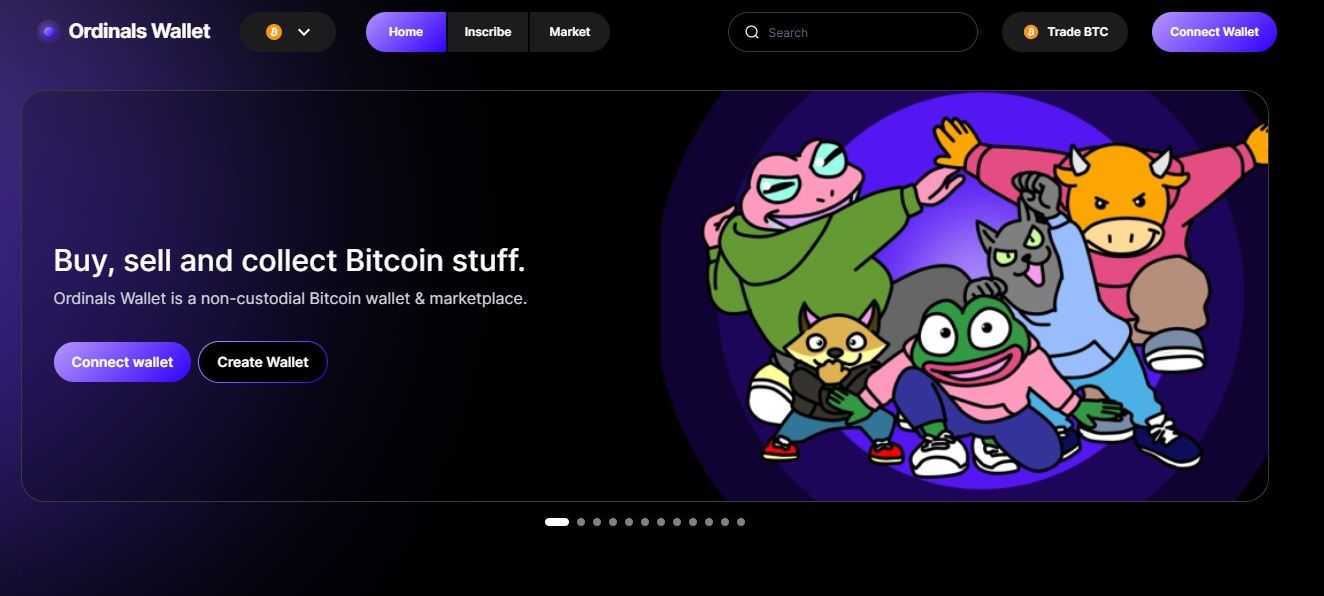
The wallet boasts impressive statistics, including over $82 million in total trading volume, more than 875,000 Ordinals inscribed, and over 470,000 wallets created. Additionally, there have been over 545,000 successful trades facilitated through the platform.
Xverse
Xverse is an open-source, non-custodial Bitcoin wallet supporting various Bitcoin layers like Stacks, Lightning, and Ordinals. It's available on iOS, Android and Chrome desktop devices.
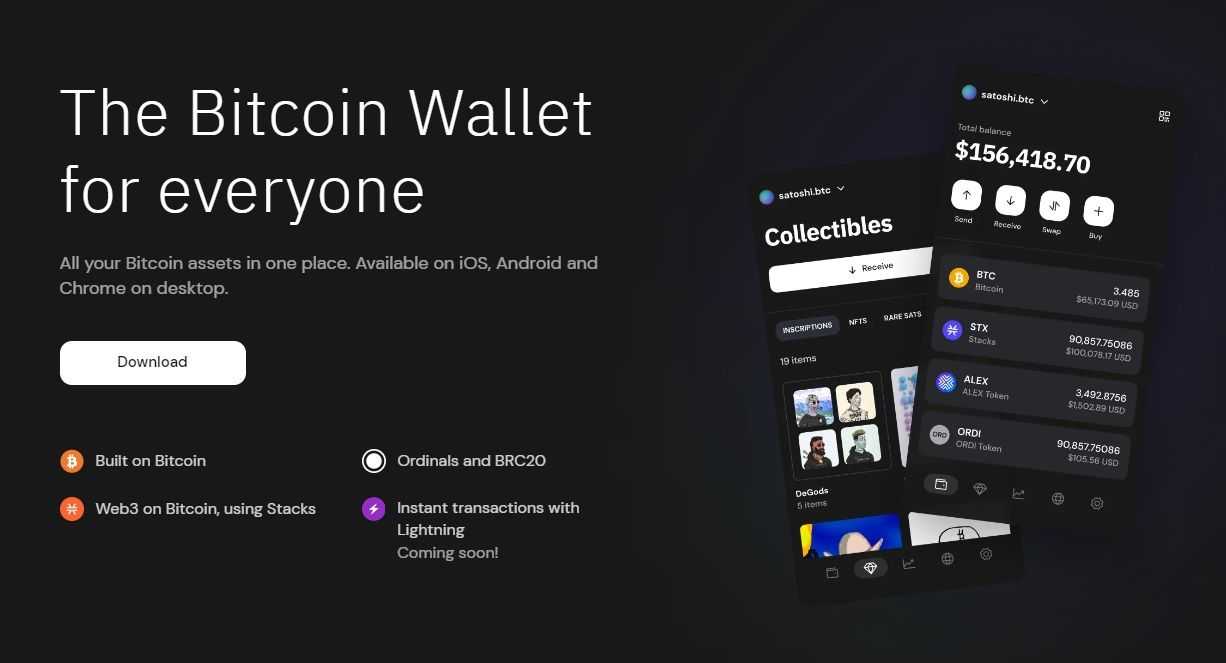
It prioritizes user privacy by not collecting or storing any user data, making it non-KYC (Know Your Customer). This means users can create wallets without undergoing KYC or AML processes.
Turning to security, the wallet encrypts private keys on the user's device using their password and does not share them with anyone. Xverse's code is open source and undergoes regular audits by companies like Least Authority. The Xverse wallet also has built-in Ledger support.
Leather Bitcoin Wallet (formerly known as Hiro Wallet)
Leather is a non-custodial software wallet designed for managing BTC and various alternative Bitcoin assets like Ordinals, BRC-20 tokens, Stamps, and Runes.
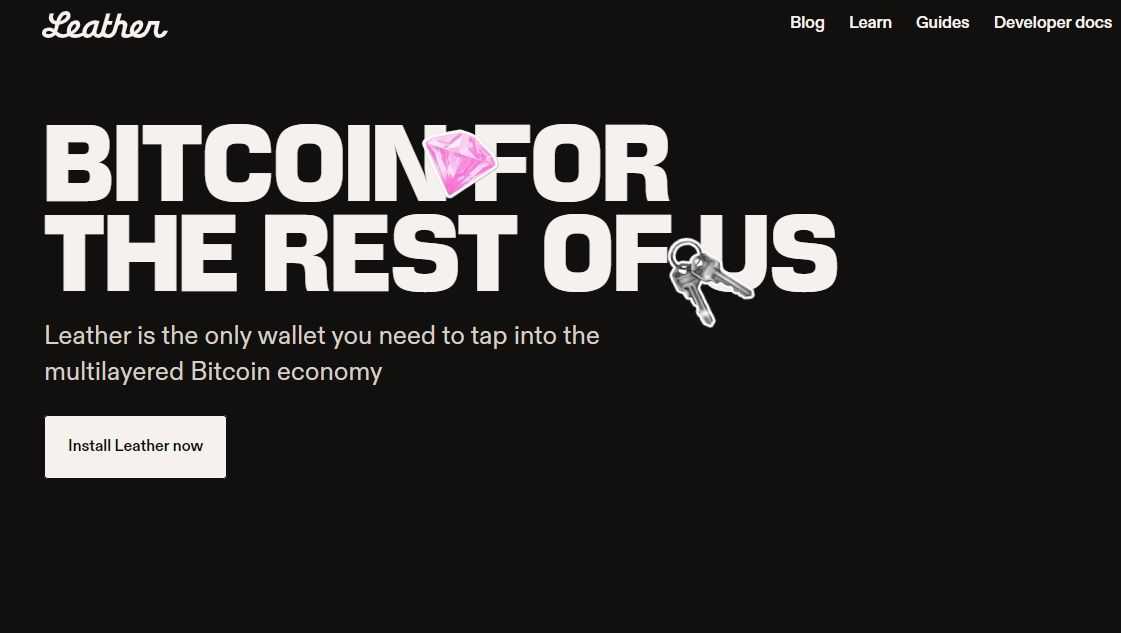
It boasts over 375,000 total downloads to date and maintains a strong user base with more than 100,000 active monthly users. The wallet processes over 300,000 transactions per month. Leather Wallet allows users to deposit, view, create, trade, and transfer assets on the Bitcoin mainnet. Additionally, Leather supports Bitcoin layer 2 chain Stacks, with Lightning Network support expected soon.
Beyond asset management, Leather provides access to numerous decentralized applications, including NFT Marketplaces like Gamma and Magic Eden, and decentralized exchanges such as ALEX and Velar. The wallet is also compatible with Ledger hardware devices.
Phantom Wallet
Phantom Wallet is designed to simplify the management of various assets, including Bitcoin, Ordinals, and BRC-20 tokens. It integrates features from Solana, Ethereum, and Bitcoin, allowing users to manage their portfolios seamlessly across different chains.
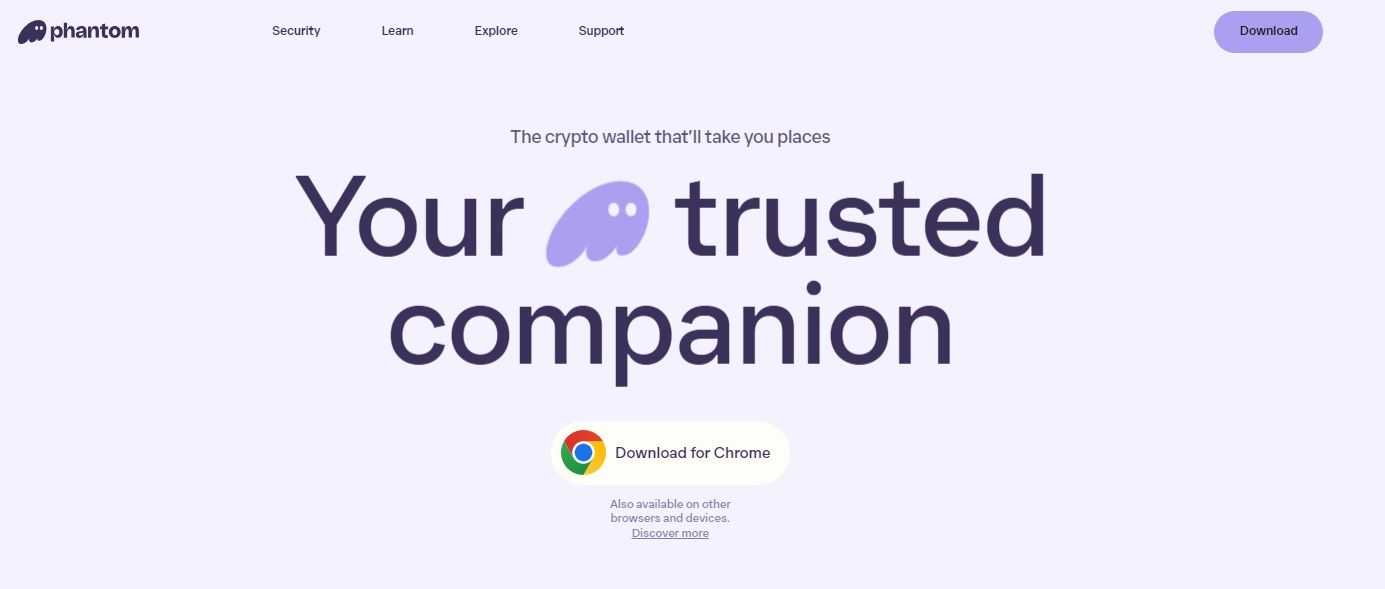
With Phantom, users can buy, sell, trade, and transfer BTC, Ordinals, and BRC-20 tokens with ease. The wallet offers convenient address management options, transaction overviews, and protection against accidental spending of rare assets.
Additionally, Phantom provides access to connected apps for exploring and engaging with the decentralized ecosystem. It also includes features like an immersive Ordinals gallery and automatic spam detection for enhanced security.
The company plans to add Ledger support and custom gas fees sometime in the future.
OKX Wallet
OKX Wallet is a decentralized multi-chain wallet designed to provide users with access to the world of Web3. It offers access to over 1,000 DApp protocols, including features like multi-chain and cross-chain decentralized exchanges (DEX), yield farming, NFT marketplaces, and DApp discovery.
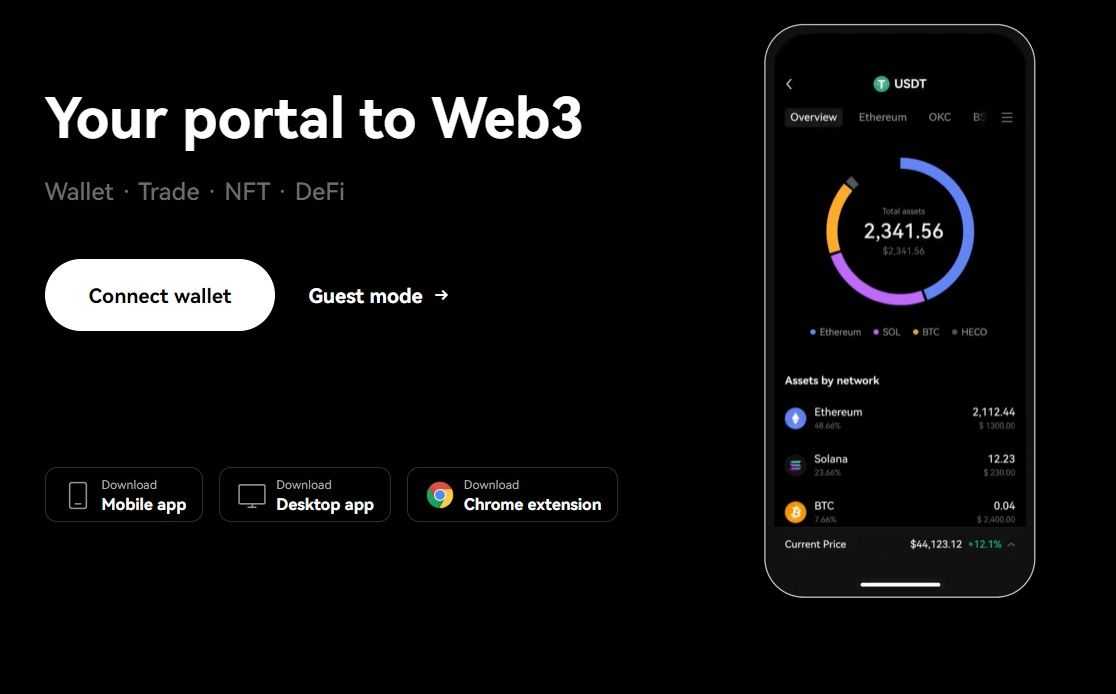
Decentralization ensures that users have full control over their assets and are responsible for securing their wallet's private keys and passwords. OKX Wallet emphasizes security, having passed a security key audit by Slowmist, and it assures users that it never saves seed phrases, private keys, or passwords, nor does it send such information to external servers.
With OKX wallet, you can:
- View and transfer Ordinals
- Trade BRC-20 tokens (buy, sell, and list)
- Mint Ordinal inscription NFTs and BRC-20 tokens
- Trade Ordinals (buy, sell, and list)
How To Choose The Best Ordinals Wallet
Choosing the right wallet for managing Ordinals is paramount to ensuring the security and effectiveness of your digital asset management.
Ordinals represent an emerging frontier within the cryptocurrency space, offering unique opportunities for digital asset ownership and trading. However, due to their experimental nature and the potential value they may hold, it's important that you choose a wallet that can adequately handle and safeguard these assets.
Here are a few things to keep in mind:
- Security Features: One of the primary considerations when choosing an Ordinals wallet is the level of security it offers. Since Ordinals represent valuable digital assets, robust security features are essential to protect against unauthorized access and potential theft. Look for wallets that provide features such as encryption, multi-factor authentication, hardware wallet integration, and secure backup options for seed phrases or private keys.
- Ease of Use: A user-friendly interface and intuitive design can significantly enhance the overall experience of managing Ordinals. Look for wallets that offer seamless navigation, clear instructions for transactions, and convenient access to essential features without compromising on security.
- Compatibility: In addition to ensuring the wallet you choose does indeed support Ordinals, you should consider whether the wallet is compatible with other cryptocurrencies or digital assets you may hold.
- Community Trust and Reputation: Consider the reputation and trustworthiness of the wallet provider within the cryptocurrency community. Look for wallets that have a proven track record of security, reliability, and transparency. Research user reviews, ratings, and feedback from other users to gauge the community's sentiment towards the wallet and its performance over time.
Tips for Using a Crypto Wallet
Here are some practical tips and best practices you can follow to keep your Ordinals wallet safe.
- It's essential to back up your wallet's seed phrase or mnemonic phrase securely. This seed phrase serves as the only way to regain access to your assets if you lose access to your wallet. Store your seed phrase offline in a secure location to prevent unauthorized access.
- Enabling two-factor authentication (2FA) adds an extra layer of security to your wallet. This typically involves requiring a second form of verification, such as a code sent to your mobile device, in addition to your password.
- Regularly updating your wallet software with the latest security patches and updates is also a key consideration. These updates are typically rolled out to fix known vulnerabilities and make security improvements.
- Exercising caution and vigilance against phishing attempts is paramount. Be wary of requests or messages from unknown senders as they may be phishing attempts designed to steal your personal information or access to your wallet. Avoid clicking on suspicious links or downloading software from unknown sources.
- Verify the authenticity of apps and websites before using them to access your Ordinals wallet. Only download wallet apps from trusted sources, such as the app's own website.
- Continuously educating yourself about the latest security threats and best practices for protecting your digital assets is also essential.
Be sure to check out our Crypto Safety Guide, where we go into further detail on wallet safety to help you navigate the crypto waters safely.
Best Ordinals Wallets: Closing Thoughts
The emergence of Bitcoin Ordinals represents an exciting development in the cryptoverse, offering unique opportunities for digital asset ownership and trading directly on the Bitcoin blockchain. As Ordinals continue to gain traction, selecting the right wallet to manage these assets is paramount to ensuring security and effectiveness.
When choosing an Ordinals wallet, it's essential to prioritize security features, ease of use, compatibility, and the provider's reputation within the cryptocurrency community. Wallets like The Ordinals Wallet, Xverse, Leather Bitcoin Wallet, Phantom Wallet, and OKX Wallet offer robust features tailored to meet the needs of Ordinals traders and investors.
With the right wallet and adherence to best practices, users can navigate the crypto landscape with confidence.
Frequently Asked Questions
Ordinals can be fungible or non-fungible data attached to individual Satoshis on the Bitcoin Blockchain, allowing for the inscription of unique digital assets.
While both Ordinals and traditional NFTs serve to authenticate and represent unique digital assets, Ordinals are specifically created and managed on the Bitcoin blockchain. They can be fungible or non-fungible, whereas traditional NFTs are typically associated with blockchains like Ethereum.
An Ordinals wallet is a digital wallet specifically designed to store, manage, and trade Ordinals on the Bitcoin blockchain. These wallets provide users with the necessary tools and functionalities to interact with Ordinals securely.
Some Ordinals wallets may offer compatibility with hardware wallets, such as Ledger devices, for enhanced security. Users can leverage hardware wallets to store their private keys offline and protect their assets from online threats. However, not all Ordinals wallets may support hardware wallet integration, so users should verify compatibility before proceeding.
When selecting an Ordinals wallet, consider factors such as security features, ease of use, compatibility with your devices, community trust, and reputation. Look for wallets that offer robust encryption, support for Taproot, and positive feedback from users.
Disclaimer: These are the writer’s opinions and should not be considered investment advice. Readers should do their own research.

